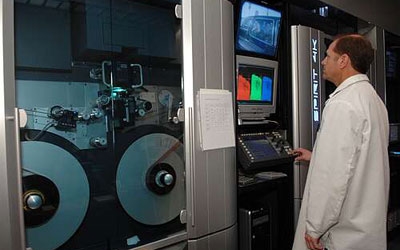Blade Runner: How Great HD is Made Page 2

It is in this facility that the original movie negatives from the nearby Warner Bros. vault (in which films are kept at a brisk 45°) go digital. The "4K" refers to the 4,000 lines of resolution at which the movies are scanned - more than triple that of 1080p high-def. And for even more perspective: Your typical theatrical film tops out with a rez of 3K to 4K (few actually reach the 4K level). The idea is to squeeze every pixel of detail out of the celluloid, essentially preserving the original movie in perfect digital condition forever. After all, who knows how long high-definition will last before higher definition nudges in? And even now, select digital cinemas are popping up with 4K projection.
Although the 4K master gets downconverted to 2K for Blu-ray and HD DVD, Cookson and Price note that they still get better high-def detail if they work down from 4K. In fact, earlier that day in another Burbank building, John Lowry showed me how a standard DVD of the James Bond movie Goldfinger, which he scanned at 4K, trumped a less-than-masterfully mastered early Blu-ray Disc of a film that shall remain nameless. The Blu-ray had a number of obvious flaws, including contrast issues and pixelation, while the Bond DVD was so loaded with clear detail that this was the disc that actually looked high-def.
Meanwhile, back at Warner Bros., film stock is constantly flowing through that 4K room. The studio not only scans movies for release on HD DVD and Blu-ray, it uses this room to preserve old gems (and even some old cubic zirconia) from its early days of cinema. Some of the prints are so fragile that they have their own 4K scanner - a table-sized machine that transports film via rollers only, scanning several frames a second. The other scanner uses pin registers for films with sprockets hardy enough to withstand being run through it. As each frame is scanned, which takes several seconds, a technician uses a computer monitor to check on the red, blue, and green color levels.
"Sometimes we see much more in the electronic process in 4K than we did in the original theatrical release prints," Ned Price notes. "You can actually see the 'seams.' So occasionally we have to double-check to see how much was revealed in the original release or how it looked. If there are matte shots, which come across very differently from the original camera negative onto video, you kind of have to dumb them down to replicate the print."
Objecting to the phrase "dumb them down," Cookson interjects, "Don't quote us on that."
The Sounds of Science Blade Runner's video wasn't the only aspect of the film that got a bump up to first class. While the original DVD had a Dolby 2.0 Surround track, the restored version adds a few more channels, bringing the total to 5.1. One of the major challenges: "There were lots of tracks that were starting to deteriorate from age," says Kurt Galveo. "We had to stop that aging. Plus, there was a lot of other work that had to go into the sound. A spinner [flying car] would go by, and it was just a loud noise. We cleaned it up and blew it out. Now it has a nice roar that you'll hear go across your room."
In general, with the new high-resolution sound starring on Blu-ray and HD DVD, "the bar has been raised," says Price. In fact, when restoring older films, "we go back to the original sound recordings, and they reveal a lot more information than what was heard in a theatrical environment. You can hear things, like the cars and trucks outside the shooting location, that was actually part of the production but not meant to be part of the film. So you want to make sure you reveal a certain amount of information without going contrary to the original nature of the track as it was heard in the theater."
The information the studio definitely doesn't want transferred to any high-def discs is the kind of fossilizing left behind by dirt and scratches - often a problem when transferring older titles. In fact, when a movie goes high-def, it must spend time at the station of the dirt-and-scratches guy. The technician - in this case, editor Steve Sanchez - attacks blemishes like a vat of Clearasil. On the day I dropped by, he was in the process of removing no fewer than 13,000 glitches from a mere half-reel (that's about 10 minutes) of the Dirty Harry movie The Enforcer (coming soon to high-def).
The next stop is at the mega-console of Jan Yarbrough, technical director of motion picture imaging, who does color correction and enhancement. Jan, also working on The Enforcer, has had to take the film's deteriorating color and make it look natural (not easy, when skin tones have taken on the look of a fatally bad fake tan).
The whole process is even bigger than just going high-def. With film being transferred onto 4K-capable LTO (Linear Tape Open) magnetic tape, and being moved around the imaging building via servers that collectively hold 700 terabytes, this isn't the Warner Bros. that Bugs Bunny knew. (Fun facts: a finished film typically takes up 12 terabytes. The raw footage goes over 1 petabyte - or 1,000 terabytes.)
"It's the most exciting time you can imagine," Cookson declares. "Literally, if you had come to work here at the time of the original Jazz Singer, and you worked your entire career and retired, and your kids worked their entire careers here and retired, nothing fundamental about the process would have changed. But if you started here 10 years ago, in another 10 years, you'll see almost nothing in common here to the way it was run before."



























































